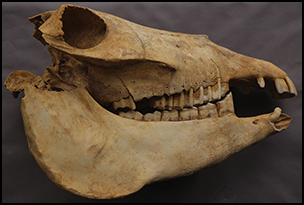Crossref Citations
This article has been cited by the following publications. This list is generated based on data provided by
Crossref.
Hu, Songmei
Hu, Yaowu
Yang, Junkai
Yang, Miaomiao
Wei, Pianpian
Hou, Yemao
and
Marshall, Fiona B.
2020.
From pack animals to polo: donkeys from the ninth-century Tang tomb of an elite lady in Xi'an, China—CORRIGENDUM.
Antiquity,
Vol. 94,
Issue. 377,
p.
1396.
Taylor, William
Wang, Juan
and
Hart, Isaac
2020.
Understanding the prehistory of domestic animals in East and Central Asia through scientific archaeozoology.
Journal of Archaeological Science: Reports,
Vol. 32,
Issue. ,
p.
102397.
Mota-Rojas, Daniel
Braghieri, Ada
Álvarez-Macías, Adolfo
Serrapica, Francesco
Ramírez-Bribiesca, Efrén
Cruz-Monterrosa, Rosy
Masucci, Felicia
Mora-Medina, Patricia
and
Napolitano, Fabio
2021.
The Use of Draught Animals in Rural Labour.
Animals,
Vol. 11,
Issue. 9,
p.
2683.
Wordsworth, Paul D.
Haruda, Ashleigh F.
Miller, Alicia Ventresca
and
Brown, Samantha
2021.
The earliest water buffalo in the Caucasus: shifting animals and people in the medieval Islamic world.
Antiquity,
Vol. 95,
Issue. 383,
p.
1231.
Seyiti, Shamila
and
Kelimu, Abulimiti
2021.
Donkey Industry in China: Current Aspects, Suggestions and Future Challenges.
Journal of Equine Veterinary Science,
Vol. 102,
Issue. ,
p.
103642.
Vázquez, Cristina
Vallejo, Asier
Vergès, Josep M.
and
Barrio, Ramón J.
2021.
Livestock activity biomarkers: Estimating domestication and diet of livestock in ancient samples.
Journal of Archaeological Science: Reports,
Vol. 40,
Issue. ,
p.
103220.
Bukhari, Syed S. U. H.
McElligott, Alan G.
and
Parkes, Rebecca S. V.
2021.
Quantifying the Impact of Mounted Load Carrying on Equids: A Review.
Animals,
Vol. 11,
Issue. 5,
p.
1333.
Zhang, Zhenwei
Huang, Bingjian
Wang, Yonghui
Zhu, Mingxia
Liu, Guiqin
and
Wang, Changfa
2023.
A survey report on the donkey original breeding farms in China: Current aspects and future prospective.
Frontiers in Veterinary Science,
Vol. 10,
Issue. ,
Wassie, Awoke Melak
Getachew, Teklewold Belayhun
Kassa, Abebe Hailu
Megersa, Ashenafi Getachew
and
Ayele, Tesfalem
2023.
Donkey production systems and breeding practices in selected districts of South Omo Zone, southern Ethiopia.
The Rangeland Journal,
Vol. 45,
Issue. 3,
p.
97.
Shea, Eiren L.
2023.
Riders in the Tomb: Women Equestrians in North Chinese Funerary Art (10th–14th Centuries).
Arts,
Vol. 12,
Issue. 5,
p.
201.





